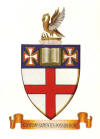
Blazon of the Serampore College
The coat of arms . . . is . . . good heraldry — for a change. . . . Technically the term "crest" applies only to the device worn on the top of the helm, though the term has come to be used for the entire "achievement of arms" or "coat of arms." In this version, the helm is omitted; I assume the cloud beneath the nest is part of it, though it might be a blurred version of the torse, the twisted wreath of the principal colors that used to hid the joint between the helm and crest. The crest is technically blazoned "a Pelican in her piety, Or," (Or = gold) a device that is iconographically a type of Christ as the Pelican is supposed to feed her brook by wounding ("vulning") her own breast to draw blood to feed her young.
I would blazon the shield (describe it in heraldic Norman French) as: "Argent, a cross gules; on a chief azure an open book Or between two crosses paty gules fimbriated Or voided argent" (or possibly "of the field"). This means "Silver, a red cross (for St. George and England), on a broad blue band at the top of the shield, a gold open book between two red crosses paty (formy, Patee) edged with gold and cut out in the center. The reason for this odd way of going about things is that the general rule in heraldry is that charges on a shield aren’t permitted to have a color on a color or metal (gold/yellow or silver/white) metal on a metal. Thus a red cross would not go on a blue background, unless fimbriated, or edged, with a metal or color to keep the color rule unviolated. This is supposedly for visibility, and the only exception (unless the entire shield is parted between two colors) is the coat of arms of Jerusalem, with its gold Jerusalem cross on a silver field. Anyway, the two crosses are either double fimbriated, which makes no sense to me, or they are red crosses edged with gold to prevent the colors touching. Then the white is "voided" or cut out to the field, which I am taking to be the white of the main portion of the shield. It might also be possible to say that the red cross was surmounted by a cross paty argent (or "of the first" as argent was mentioned in the blazon right away). The motto means something like "the wise shall possess glory." But I am no Latinist.
That is how I would blazon the coat, and blazon is still the only correct way to describe a coat of arms officially. . . . The other thing is to be careful with interpreting a coat of arms: most are not symbolic. This is more so — the book/Bible, the crosses, the English red cross, and, of course the Pelican crest.
James F. R. Day
Professor of English
Troy State University
Troy, Alabama
U.S.A.
The Center gratefully acknowledges Dr. James F. R. Day for this blazon.
Created: January 24, 2002 Updated: July 27, 2012